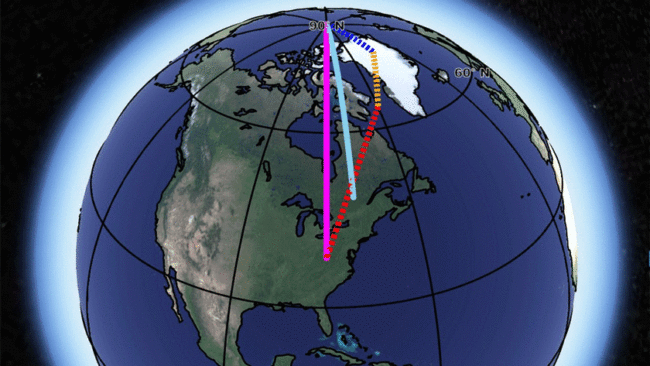
If you imagine a line right through the planet from North Pole to South pole then you can use this to visualise in your mind Earth’s spin axis. It is not static, but drifts and wobbles by as much as 4” per year, or 11 yards per century. This “Polar Motion” has been observed but we have never truly understood why … until now.
There have been models, but they did not align with actual observations, so clearly we did not fully understand it.
NASA has an Answer
There is a paper that has just been published – “What drives 20th century polar motion?”. The abstract explains …
Astrometric and geodetic measurements show that the mean position of Earth’s spin axis drifted through the solid crust toward Labrador, Canada at an average speed of 10.5 ± 0.9 cm/yr during the 20th century.
Understanding the origins of this secular polar motion (SPM) has significance for modeling the global climate, as it provides a link to ice mass balance and sea-level rise. A perplexing issue, however, is that while glacial isostatic adjustment (GIA) models satisfactorily explain the direction of SPM, the associated prediction of the amplitude is insufficient. Our Bayesian GIA analysis, with constraints from relative sea-level and vertical land motion data, reveals that this process only accounts for 33 ± 18% of the observed SPM amplitude. This shortfall motivates a more broadly scoped reassessment of SPM drivers.
To address this, we assemble a complete reconstruction of Earth’s surface mass transport derived from recent advancements in modeling the global 20th century cryospheric, hydrologic, oceanic, and seismogenic mass exchange. The summed signals, nonetheless, cannot fully reconcile the observed SPM, even when considering the error statistics of each driver. We investigate an additional excitation source: changes in Earth’s inertia tensor caused by mantle convection. Sophisticated models have recently been advanced in tectonic plate reconstructions, in conjunction with geoid and seismic tomographic models.
Here we use these models to compute new estimates of SPM. While the convection-driven SPM has considerable uncertainty, the average direction of 283 recent models aligns with the residual SPM (within 2.7 • ± 14.8 •), significantly reducing the gap between observation and prediction. We assert that one key mechanism for driving 20th century SPM is long-term mass movement due to mantle convection.
OK, let’s translate and expand upon the details of all that.
The redistribution of mass on and within Earth — like changes to land, ice sheets, oceans and mantle flow — affects the planet’s rotation. It has been assumed that the primary driver was glacial rebound (ice melts and the mantle under it shifts).
But crunch the numbers and that only explains 18% of what has been observed, so something else is going on.
What the new study reveals is that there are in reality three primary forces in play …
- contemporary mass loss primarily in Greenland
- glacial rebound
- mantle convection
In other words, the melting of 7,500 gigatons of ice in Greenland over the course of the 20th century has literally changed the axis of the entire planet.
OK, let me replay that once again.
Climate Change over the course of the 20th century has literally changed the axis of the entire planet.
That is quite frankly stunning.
But that is Glacial Rebound … right?
Well no. What they mean when they use the term “Glacial Rebound” is that during the last ice age, heavy glaciers depressed Earth’s surface much like a mattress depresses when you sit on it. As that ice melts, or is removed, the land slowly rises back to its original position. In this new study, which relied heavily on a statistical analysis of such rebound, they figured out that glacial rebound is likely to be responsible for only about a third of the polar drift in the 20th century.
A huge factor has been the loss of huge amounts of ice in Greenland. If you imagine a spinning top, placing a weight directly at the top, and then removing that weight … it will not alter to spin. But place the same weight at about 45 degrees (roughly where Greenland is) and then removing that mass – that will impact the spin. This accounts for one third.
The final force is mantle convection. Plate tectonics is being driven by this. It is basically the circulation of material in the mantle caused by heat from Earth’s core. It is similar to a pot of soup placed on the stove. As the pot, or mantle, heats, the pieces of the soup begin to rise and fall, essentially forming a vertical circulation pattern — just like the rocks moving through Earth’s mantle.
It is these three that together, when modelled, bring us very close to actual observations.
As already has been mentioned, what is quite frankly stunning is that about one third of the effect in the 20th century is due to climate change.
They have a visual illustration
NASA have an interactive simulation of how multiple processes contribute to the wobbles in Earth’s spin axis.
You can find it here … https://vesl.jpl.nasa.gov/sea-level/polar-motion/
Did the earth move for you?
If ever asked “Did the earth move for you?”, then the most honest answer in the context of the CO2 we all emit is perhaps “Yes”.
